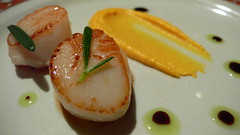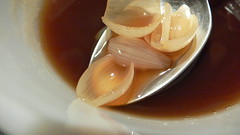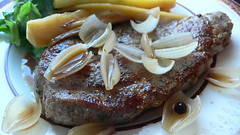Noma 2: Manic Cuisine
It may be March already, but with Montreal still in process of digging itself out from under yet another blizzard, it seems like an appropriate time to complete our Noma series...
We may have started slowly with Noma: Nordic Cuisine, but when it came to putting it to the test a second time, we threw all caution into those arctic February winds.
Now some of you hotshots out there who've skimmed ahead might be thinking to yourselves, "Two courses--that's it?" Yeah, that's it. But as you'll notice once you read things through carefully, there are a number of different parts to each course, we started the meal at about 5:30 on a weeknight (except for the Day 1 and Day 2 steps, of course), and you see where it lists "chicken stock" down below? Well, for some reason we decided to make our own that very night. Making our own chicken stock from scratch isn't all that weird for us--we do so with frequency--however, making chicken stock simultaneous to the preparation of the very meal that calls for chicken stock in the first place is a litttle strange, even for us. I point this out not out of some pathetic desire to impress you, dear readers, but rather to convey the ambience in the kitchen on that particular night, an ambience that could quite succinctly be described as "manic." Not "manic-bad," mind you, just "manic." And, actually, once we got into the swing of things that night, we were able to relax--considerably. The meal was so labor-intensive for a weekday dinner for two that it was laughable, so laugh we did, especially when the recipes forced us to muster up a little on-the-spot ingenuity (you'll see what I mean momentarily). Still, we were eating by 8:30, so that's not so bad.
We'd selected our menu based on two criteria: we definitely wanted to choose recipes that were seasonal, seasonality being such an important part of the Noma philosophy, and we definitely wanted to choose recipes whose ingredients we could actually find in Montreal (or invent in our kitchen, as it turns out), because unlike the folks at Noma, we weren't in a position to start establishing trade agreements with Greenlandic fisherman. Besides, Noma is all about regionality (albeit pan-Nordic regionality), so we didn't see the point in attempting to track down authentic Faroe Islands langoustines or whatnot. So we settled on Cured Brisket of Pork with Potato Skins and Beer-Cured Onions, with a stripped down version of Sautéed Bay Scallops with Leeks, Dill, and Crème of Egg Yolks as an appetizer. If our logic here isn't clear, it went something like this: a) Quebec is definitely a pork culture, it's also a potato culture, a beer culture, and an onion culture, and we love all of the above, so, all right... Check! b) bay scallops are a little hard to find around here, but sea scallops sure aren't, seeing as the St-Lawrence basin is one of the world's finest sea scallop habitats, so that works, and so do leeks, dill, and eggs, and we love all of those ingredients too, so it's too bad we're going to scratch the leeks, but it'll sure make things easier... Check! Truth be told, more than anything it was the juniper berries--a spice typical of traditional Québécois cuisine--that sold me on the pork, and then we just took it from there.
Now, if you want make the Noma meal exactly the way we did, you're going to have to allot three days to the cause, but, as you'll see, there's a simplified version way down below that can be fully realized in the space of just a few hours that's also very satisfying, so you may very well want to follow that path instead.
 fig. a: scallops by Noma as interpreted by us
fig. a: scallops by Noma as interpreted by us
Sautéed Scallops with Dill and Crème of Egg Yolks
seared scallops:
4 medium-size scallops
sugar and salt
1 tbsp grapeseed oil
1 tbsp of butter cut into 4 nubs
4 rosemary leaves
Toss the scallops in a little bit of sugar and salt and let them marinate for a few hours or, preferably, overnight. When the scallops have marinated, heat the grapeseed oil in a well-seasoned or nonstick pan over medium-high heat. When the oil has reached temperature, sear the scallops gently on both sides--you want them to have a golden crust and no more. When you turn the scallops over onto their second side, place a butter nub and a rosemary leaf on each. When the second side has a nice golden crust, you're ready to serve.
dill oil:
1 tbsp dill
1 tbsp flat-leaf parsley
grapeseed oil
Blanch the dill and the parsley in salted water. Cool the herbs down with a cold-water or ice-water bath. Wring them dry and place them in a blender. Add just enough oil (roughly 4-6 oz.) to blend the herbs into a loose purée. Strain the oil with a fine mesh and discard the solids.
crème of egg yolks:
3 boiled egg yolks (yolks from eggs that have been boiled for precisely 9 minutes)
35 g / 3 tbsp capers-brine (the brine from a jar of capers)
25 ml / 5 tsp chicken stock, preferably homemade
20 g / 2 tbsp breadcrumbs
1 medium carrot, peeled and boiled
200 ml / 3/4 cup grapeseed oil
1 tsp toasted peanut or sesame oil
salt and lemon juice
Blend the egg yolks with the capers-brine, the chicken stock, the breadcrumbs, and the carrot. Pour in the grapeseed oil a little bit at a time and continue blending. Then, using your judgment, add the peanut oil, the salt, and the lemon juice until you have an extremely tasty but loose purée (keep in mind that the capers-brine is very, well, briny, so you may not need any salt at all). Strain the crème.
assembly:
Place two seared scallops on a plate. Place a flamboyant smear of the egg crème alongside. Drizzle some dill oil around the scallops in a circular pattern. Drizzle a tiny bit of balsamic vinegar in the same circular pattern as the dill oil. Serve immediately.
Serves 2 as an appetizer.
[adapted slightly from Noma: Nordic Cuisine]
At this point, if you skim ahead just a bit you'll notice that Noma's "Cured Brisket of Pork" has metamorphosed into "Cured Pork Belly." We based this adjustment on the accompanying photograph in Noma: Nordic Cuisine, on the fact that the cookbook is littered with minor mis-translations, and on simple common sense.
 fig. b: Noma does pork
fig. b: Noma does porkCured Pork Belly with Potato Skins and Beer-Cured Onions
1 kg / 2.2 lb pork belly
1/2 tbsp juniper berries
1/2 tbsp coriander seeds
1/2 tbsp green anise
1/2 tbsp caraway
1 rosemary branch, leaves removed, minced
1 thyme branch, minced
14 g / 2 tbsp salt
lard, preferably smoked
grapeseed oil
Two days before your meal, toast the spices in a dry pan till the caraway and anise is just golden and the combination becomes highly aromatic.
fig. c: toasting spices
Crush the spices and the salt together in a mortar to make a rub. Clean the pork belly and dry it. Using your fingers, coat the pork belly on all sides with the rub.
On Day 2, preheat the oven to 80º C. Clean the pork belly of the spices. Cover the pork with a thin layer of lard and put it in a roasting pan. Put the meat in the oven and cook slowly for 12 hours.
Remove the brisket and place under pressure (i.e., under a cutting board) to compress it and put it in the refrigerator overnight.
On Day 3, score the rind of the pork belly and then slice it into oblong pieces. Sauté these pieces slowly in a little bit of oil over medium heat until they are crispy and warm at the edges.
sauce:
3 tbsp balsamic plum vinegar (or 3 tbsp "balsamic plum vinegar," i.e., 2 tbsp ume plum vinegar mixed with 1 tbsp balsamic vinegar)
1/2 rosemary branch
4 juniper berries
50 ml / 3 tbsp + 1 tsp apple juice
200 ml / 3/4 cup chicken stock, preferably homemade
100 ml / 1/3 cup+ weissbier or blanche
In a saucepan over medium-high heat, reduce the vinegar with the rosemary and the juniper berries for a couple of minutes. Add the apple juice, bring the mixture back to a boil, and reduce for another couple of minutes. Add the chicken stock and the weissbier and reduce the mixture down to half its original volume. Strain the sauce and season to taste.
 fig. d: marinated onions
fig. d: marinated onionsbeer-cured onions:
20 pearl onions, blanched then separated into shells
200 ml / 3/4 cup beer (use a good lager)
90 g / 1/2 cup honey
1 thyme branch
5 juniper berries
110 g / 3/4 cup balsamic apple vinegar (or 110 g "balsamic apple vinegar," i.e., apple vinegar mixed with balsamic vinegar in a 2:1 ratio)
Boil the beer, the honey, the thyme and the juniper berries together and reduce for 5 minutes. Take the marinade off the heat and add the balsamic apple vinegar or "balsamic apple vinegar." Pour the marinade over the onion skins and let them steep in the liquid for at least 30 minutes. Don't throw the thyme and juniper berries away--you'll want to decorate your plates with them.
 fig. e: our potatoes as they went into the oven
fig. e: our potatoes as they went into the ovencrispy potato peels:
1 kg /2.2 lb small potatoes, scrubbed
oil for frying, such as grapeseed or peanut
Bake the potatoes in the oven at 160º C until they are just tender. Take them out of the oven, allow them to cool briefly, and cut them into halves. Gently and carefully so as to preserve their shape, scoop the potato flesh out of the peels and save for another purpose (i.e., tomorrow morning's home fries). Take the peels and fry them in oil heated to 160º C until they are crispy. You may have to do this in multiple batches. Remove the peels from the oil and place them on paper towel to let them dry. Season with salt.
assembly:
Place one piece of pork belly on each plate and surround each piece with potato skins and onions. Garnish with juniper berries and thyme and/or rosemary and drizzle some sauce over the entire ensemble. Serve immediately.
Serves 4.
[recipe adapted from Noma: Nordic Cuisine]
The results were nothing if not spectacular, and several of the component parts were truly outstanding (the crème of egg yolks and the crispy potato skins, but especially the beer-cured onions), but there was one major problem: while the scallops were a total knockout, the pork belly hadn't quite worked out. The flavor was there in spades, there was nothing wrong with the approach, but for some reason the 12-hour extra slow & low roast had dried that poor pork belly out. So the pork, the star attraction, was okay, and we still enjoyed it--after three days, we kinda had to--but it was far from phenomenal, far from the succulent pork extravagance we were expecting. Longtime readers will know that we've had all kinds of success with roasting pork for eight-hour spells at a considerably higher temperature, so I think I'd just adjust the cooking time--no more than eight hours?--if I tried this recipe again, but let's not kid ourselves: we were a little disappointed.
Nevertheless, the next day the leftovers made for a pretty great sandwich consisting of pork belly, beer-cured onions, arugula, mayonnaise, and that special sauce in a hard roll. It looked something like this
 fig. f: pork belly sandwich
fig. f: pork belly sandwichand it made for a fine sandwich. Michelle quipped that it looked like Nordic banh-mi, but I wasn't willing to go quite that far.
And while I was eating my pork belly sandwich the next day, I got the idea of using the same basic formula--that aromatic rub, those beer-cured onions--to prepare a dish that would cut down on my prep time considerably and that was guaranteed to turn out perfectly. I was pretty sure that you could use that basic formula to great effect with a pork roast or a pork tenderloin, but the fundamental idea behind Noma's dish had to do with working magic with a lowly cut of meat, so I went with a pork chop--a plain, old pork chop.
A few days later, I whipped up a half version of Noma's pork rub
1/4 tbsp juniper berries
1/4 tbsp coriander seeds
1/4 tbsp green anise
1/4 tbsp caraway
1/2 rosemary branch, leaves removed, minced
1/2 thyme branch, minced
7 g / 1 tbsp salt
and rubbed it all over two healthy pork chops, then I refrigerated them overnight to let the rub work its charms. The next day I took my pork chops out of the refrigerator, wiped the rub off, and allowed them to reach something approaching room temperature, I made some more of Noma's special sauce, quickly braised some parsnips, mixed a salad, and took the leftover beer-cured onions from our previous adventure out of the refrigerator, and when the pork chops were at room temperature, I heated 1 tbsp grapeseed oil in a well-seasoned skillet over medium-high heat. Roughly ten minutes later--including about eight or nine minutes of cooking time for the chops--we sat down to this:
 fig. g: Noma-style pork chop
fig. g: Noma-style pork chopThis version maybe wasn't quite as dramatically Nordic as our previous meal had been, but it also wasn't as manic. And it was good. Damn good.
aj










3 comments:
that pork belly sandwich looks seriously good, guys.
Why grapeseed oil? And what happens to the capers once they lose their brine?
Hi Leigh,
it definitely was--those cured onions and that sauce really made it deluxe
Hi Peter,
Grapeseed oil is pretty neutral--I think that's why they like it. Who knows? Maybe they make grapeseed oil in Denmark, too
As for the capers: we happened to have a jar that was half empty, so we didn't run into that problem. I'm not sure if the folks at Noma buy capers in large quantities or if they pickle their own. They do a lot of pickling, so maybe they use the brine from some other preserve. I wouldn't use just any brine, but I'm sure you could use another kind and get similarly good results.
Post a Comment